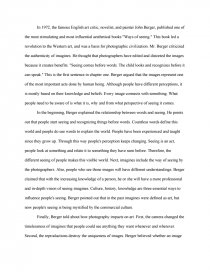Berge's Idea
Essay by Woxman • June 5, 2012 • Essay • 473 Words (2 Pages) • 1,614 Views
In 1972, the famous English art critic, novelist, and painter John Berger, published one of the most stimulating and most influential aesthetical books "Ways of seeing." This book led a revolution to the Western art, and was a basis for photographic civilization. Mr. Berger criticized the authenticity of imagines. He thought that photographers have edited and distorted the images because it creates benefits. "Seeing comes before words. The child looks and recognizes before it can speak." This is the first sentence in chapter one. Berger argued that the images represent one of the most important acts done by human being. Although people have different perceptions, it is mostly based on their knowledge and beliefs. Every image connects with something. What people need to be aware of is what it is, why and from what perspective of seeing it comes.
In the beginning, Berger explained the relationship between words and seeing. He points out that people start seeing and recognizing things before words. Countless words define this world and people do use words to explain the world. People have been experienced and taught since they grow up. Through this way people's perception keeps changing. Seeing is an act, people look at something and relate it to something they have seen before. Therefore, the different seeing of people makes this visible world. Next, imagines include the way of seeing by the photographers. Also, people who see those images will have different understandings. Berger claimed that with the increasing knowledge of a person, he or she will have a more professional and in-depth vision of seeing imagines. Culture, history, knowledge are three essential ways to influence people's seeing. Berger pointed out that in the past imagines were defined as art, but now people's seeing is being mystified by the commercial culture.
Finally, Berger told about how photography impacts on art. First, the camera changed the timelessness of imagines that people could see anything they want whenever and wherever. Second, the reproductions destroy the uniqueness of images. Berger believed whether an image is treasured or not, it depends on how unique it is. Reproduction damaged the value of images. He cited two paintings of the "Virgin of the Rocks," by Leonardo Da Vinci. One is at the National Gallery and another is at the Louvre. The two organizations try to make people believe their painting is the real one and the others are reproductions. Because of the competition, the painting loses its meaning and alienates most people from art.
Berger insists art is an essential part of people's lives. It conveys artist's emotion and experience. In addition, it is a form of hierarchies which passes on the culture and knowledge to next generations. However, the modern society changes the art to be a more mystified way, keeps people away from arts, and makes arts involve into political issue.
...
...

